
The relief of our peninsula stands out for being a mountainous relief. The mountain ranges of Spain They are characterized by having a rugged relief and divided into different altitudes, plateaus and depressions. Thanks to this type of relief, there are endemic and exclusive species of our peninsula.
For this reason, we are going to dedicate this article to tell you about the main characteristics of the mountain ranges of Spain, their relief and their importance.
relief of Spain

The territory of Spain covers 505.956 square kilometers and includes most of the Iberian Peninsula, the Balearic Islands, the Canary Islands, and the cities of Ceuta and Melilla in North Africa.
The topography that Spain presents today is the result of millions of years of geological history, profoundly influenced by the clash of the African and Eurasian plates. Added to this, endogenous processes such as volcanic activity and exogenous processes caused by external factors such as water and wind create different geological formations within the territory.
Therefore, Spain presents a great diversity in the topography of its peninsular and insular territories and submerged areas. To know what type of relief there is in Spain, we must first understand the characteristics that make it up. First, let's take a look at the terrain features of the peninsula:
- Altitude: The average altitude is 660 meters.
- Form: Due to the width of 1094 kilometers from east to west, added to the extension and linearity of the coast, its shape is quite massive, quadrangular and almost equilateral.
- Mountain System: With the exception of the Sierra Ibérica and the Sierra Litoral Catalana, the mountains run from east to west and form a natural barrier against the humid winds from the Atlantic Ocean.
- Internal distribution of the land: The territory of Spain is organized into units of the central plateau, which represent 45% of the land area of Spain. Surrounded by ridges, troughs, and outlying mountains.
The characteristics of the Spanish insular relief can be divided into the following:
- Balearic Islands: Compared to the Canary Islands, its relief is slightly more mountainous. In addition, the Balearic Islands form a geographical extension of the Baetic Mountains in the Mediterranean Sea, which is why they have a peninsular topography. On the other hand, the Canary Islands are completely independent due to their volcanic origin and location.
- Canary Islands: formed by magma ejected from the African plate fault zone, and the magma solidified to form islands. In these Canary Islands, where volcanic activity is still active, the terrain is volcanic and we usually find calderas, cones, calderas, badlands, canyons and glaciers.
Now that you know the general characteristics of the peninsular and insular reliefs, we are going to detail the different relief units in Spain.
mountain ranges of Spain

central plateau
It is the main topographical feature of Spain, a vast plain crossed by rivers that finally flow into the Atlantic Ocean. It covers the center of the Iberian Peninsula, passing through the communities of Castilla-León, Castilla-La Mancha and Extremadura. In turn, the highlands are divided into two regions by the central mountain system:
- North sub-plateau or Duero depression: crossed by the river Duero.
- Sub-plateau or southern depression Tagus-Guadiana and La Mancha: crossed by the Tagus and Guadiana rivers.
mountain system
On the other hand, there are three groups of mountains in the Spanish territory, let's see what they are:
Mountains within Plateau
Two of them, as their name suggests, are located in the center of the plateau:
- Further north is the Central Sistem: formed by the mountains of Somosierra, Guadarrama, Gredos and Gata, Almanzor being the highest peak.
- A little further south are the Toledo Mountains: a lower mountain range. There is the Sierra de Guadalupe and Las Villuercas, the highest peak of the sierra.
Mountains around the plateau
The mountains that border the Central Plateau are:
- Mountains of León: In the northwest, its mountains are not very high, and Teleno Peak is the highest.
- Cantabrian Mountains: To the north and along the Cantabrian coast. There are high-altitude mountains here, with the Torre de Cerredo being the highest peak.
- Iberian System: To the east, it separates the Central Plateau from the Ebro Valley. The Moncayo peak is the highest.
- Sierra Morena: To the south, a mountain range that separates the central plateau from the Guadalquivir Valley. The mountains are not very high, here we find the Sierra Madrona, with Bañuela being the highest.
Mountain ranges of Spain off the plateau
In the farthest reaches of the central plateau we find the following mountain ranges:
- Galician Massif: In the northwest they are lower, but Cabeza de Manzaneda is the highest.
- Basque Mountains: In the north, between the Pyrenees and the Cantabrian Mountains. Its Corey peak constitutes the highest altitude.
- Pyrenees: Also in the north, they form the natural border between Spain and France. They are high-altitude mountains, the highest peak being Aneto. Do not miss more details about the flora and fauna of the Pyrenees in the following Green Ecology article.
- Catalan Coastal System: To the east of the plateau, is a mountain range parallel to the Mediterranean coast. Montserrat and Montseny constitute the highest elevations.
- Baetic systems: They are located to the southeast of the Meseta and are formed by the Penibética and Subbética mountain ranges.
depression

In Spain we find two large depressions outside the central plateau. They are flat, low elevation sites between mountains with rivers running through them. Let's see what they are:
- Ebro depression: a triangular plain in the northeast of Spain, between the Pyrenees, the Iberian Mountains and the Catalan coast. The Ebro river crosses it.
- Guadalquivir Depression: Also triangular in shape, located in the southwest of Spain, between the Morena and Bética mountains. It is crossed by the Guadalquivir river.
Islands
As we mentioned previously, the Spanish territory includes two large islands, which are actually archipelagos, that is, a group of islands:
- Balearic Islands: It consists of 5 islands: Mallorca, Menorca, Ibiza, Formentera and Cabrera. They are located on the Mediterranean coast in eastern Spain. The relief of the archipelago is not so mountainous, with the Tramuntana mountains to the north of Mallorca and the highest peak is Puig Major.
- Canary Islands: There are 7 islands that make up the archipelago, Lanzarote, Fuerteventura, Gran Canaria, Tenerife, La Gomera, El Hierro and the island of La Palma. They are also found over the Atlantic Ocean in western Africa. The terrain here is mountainous of volcanic origin. The highest peak, Teide, is located in Tenerife and is the highest in all of Spain.
Back
Finally, Spain has a wide coastline divided into three sections, which are:
- Cantabrian cornice: the north coast, which extends from the border with France to the tip of the Estaca de Bares. There we found many cliffs.
- Mediterranean coast: From the Strait of Gibraltar to the French border, it is the longest coastline in Spain.
- Atlantic Coast: From the tip of the Estaca de Bares to the Strait of Gibraltar. It is actually divided into three parts: from the tip of Estaca de Bares to the Miño estuary (north of Portugal); from the southern border of Portugal to the Strait of Gibraltar; and the coast of the Canary Islands.
I hope that with this information you can learn more about the mountain ranges of Spain and their characteristics.